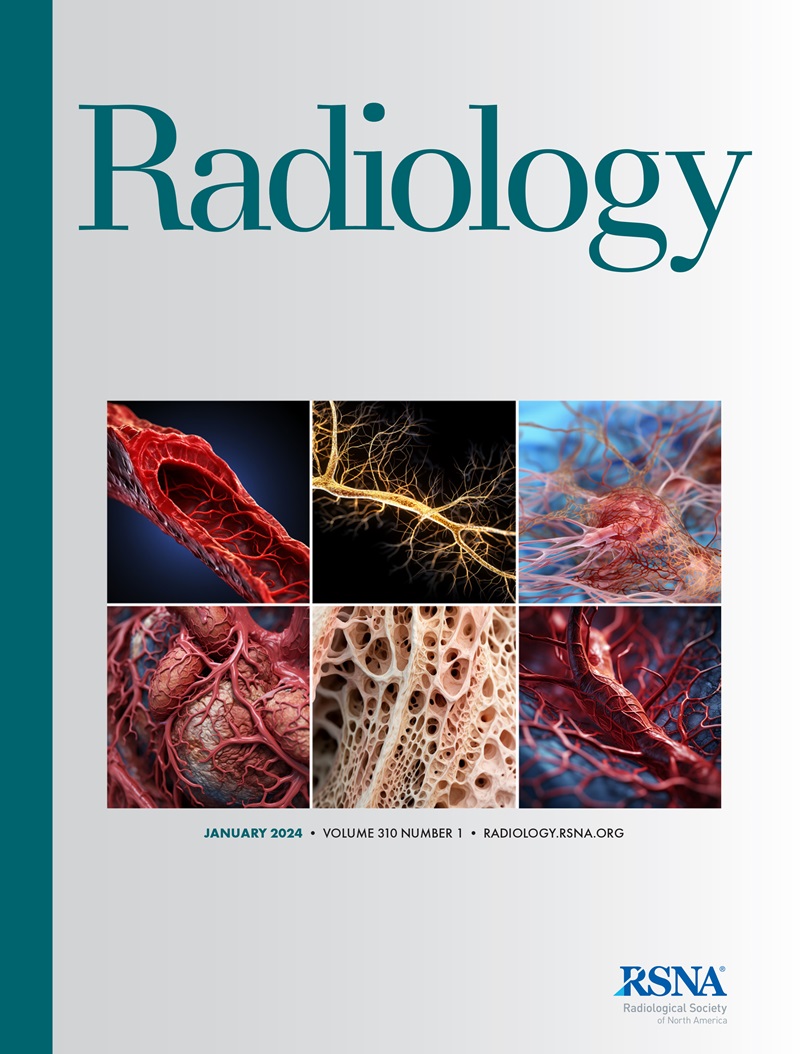Left Atrial Minimum Volume Index at Cardiac MRI Predicts Adverse Outcomes after Acute Myocardial Infarction.
IF 15.2
1区 医学
Q1 RADIOLOGY, NUCLEAR MEDICINE & MEDICAL IMAGING
Jingping Wu, Jinyi Xiang, Xingyu Gu, Lei Zhao, Binghua Chen, Dong-Aolei An, Yan Zhou, Jun Pu, Lianming Wu
求助PDF
{"title":"Left Atrial Minimum Volume Index at Cardiac MRI Predicts Adverse Outcomes after Acute Myocardial Infarction.","authors":"Jingping Wu, Jinyi Xiang, Xingyu Gu, Lei Zhao, Binghua Chen, Dong-Aolei An, Yan Zhou, Jun Pu, Lianming Wu","doi":"10.1148/radiol.250078","DOIUrl":null,"url":null,"abstract":"<p><p>Background Left atrial (LA) structural and functional parameters are associated with prognosis after acute myocardial infarction (AMI). Purpose To explore the prognostic value of LA minimum volume index (LAVI<sub>min</sub>) as measured at cardiac MRI and its incremental predictive value beyond LA functional parameters for predicting major adverse cardiovascular events (MACE) after AMI in a large population. Materials and Methods This prospective study enrolled patients with AMI who underwent percutaneous coronary intervention and subsequent cardiac MRI between February 2014 and January 2024. MACE included all-cause death, reinfarction, unplanned revascularization, and heart failure hospitalization. Univariable and multivariable Cox regression analyses were used to evaluate the association between LAVI<sub>min</sub> and MACE. Receiver operating characteristic analysis and Kaplan-Meier analysis were used to evaluate the prognostic value of LAVI<sub>min</sub> in participants with AMI. Results A total of 1191 participants (mean age, 58 years ± 11 [SD]; 1007 male participants) were included. Among them, 183 individuals experienced MACE over a median follow-up of 38 months (IQR, 20-57 months). After adjusting for clinical risk factors and cardiac MRI parameters, a larger LAVI<sub>min</sub> was independently associated with MACE (hazard ratio, 1.06 [95% CI: 1.05, 1.08]; <i>P</i> < .001). Receiver operating characteristic analysis revealed that LAVI<sub>min</sub> (area under the receiver operating characteristic curve [AUC], 0.74) had better discriminative ability for MACE than LA maximum volume index (LAVI<sub>max</sub>) (AUC, 0.65; <i>P</i> < .001) and LA conduit strain (AUC, 0.64<i>; P</i> < .001). Traditional risk predictors plus LAVI<sub>min</sub> had greater prognostic value for MACE (C index, 0.75) than traditional risk factors alone (C index, 0.69; <i>P</i> < .001) or traditional risk predictors plus LAVI<sub>max</sub> (C index, 0.72; <i>P</i> = .03). Conclusion LAVI<sub>min</sub> was an independent predictor of MACE after AMI, with incremental prognostic value and improved discriminative ability over traditional risk factors including cardiac MRI parameters. © RSNA, 2025 <i>Supplemental material is available for this article.</i> See also the editorial by Weir-McCall and Hua in this issue.</p>","PeriodicalId":20896,"journal":{"name":"Radiology","volume":"316 3","pages":"e250078"},"PeriodicalIF":15.2000,"publicationDate":"2025-09-01","publicationTypes":"Journal Article","fieldsOfStudy":null,"isOpenAccess":false,"openAccessPdf":"","citationCount":"0","resultStr":null,"platform":"Semanticscholar","paperid":null,"PeriodicalName":"Radiology","FirstCategoryId":"3","ListUrlMain":"https://doi.org/10.1148/radiol.250078","RegionNum":1,"RegionCategory":"医学","ArticlePicture":[],"TitleCN":null,"AbstractTextCN":null,"PMCID":null,"EPubDate":"","PubModel":"","JCR":"Q1","JCRName":"RADIOLOGY, NUCLEAR MEDICINE & MEDICAL IMAGING","Score":null,"Total":0}
引用次数: 0
引用
批量引用
Abstract
Background Left atrial (LA) structural and functional parameters are associated with prognosis after acute myocardial infarction (AMI). Purpose To explore the prognostic value of LA minimum volume index (LAVImin ) as measured at cardiac MRI and its incremental predictive value beyond LA functional parameters for predicting major adverse cardiovascular events (MACE) after AMI in a large population. Materials and Methods This prospective study enrolled patients with AMI who underwent percutaneous coronary intervention and subsequent cardiac MRI between February 2014 and January 2024. MACE included all-cause death, reinfarction, unplanned revascularization, and heart failure hospitalization. Univariable and multivariable Cox regression analyses were used to evaluate the association between LAVImin and MACE. Receiver operating characteristic analysis and Kaplan-Meier analysis were used to evaluate the prognostic value of LAVImin in participants with AMI. Results A total of 1191 participants (mean age, 58 years ± 11 [SD]; 1007 male participants) were included. Among them, 183 individuals experienced MACE over a median follow-up of 38 months (IQR, 20-57 months). After adjusting for clinical risk factors and cardiac MRI parameters, a larger LAVImin was independently associated with MACE (hazard ratio, 1.06 [95% CI: 1.05, 1.08]; P < .001). Receiver operating characteristic analysis revealed that LAVImin (area under the receiver operating characteristic curve [AUC], 0.74) had better discriminative ability for MACE than LA maximum volume index (LAVImax ) (AUC, 0.65; P < .001) and LA conduit strain (AUC, 0.64; P < .001). Traditional risk predictors plus LAVImin had greater prognostic value for MACE (C index, 0.75) than traditional risk factors alone (C index, 0.69; P < .001) or traditional risk predictors plus LAVImax (C index, 0.72; P = .03). Conclusion LAVImin was an independent predictor of MACE after AMI, with incremental prognostic value and improved discriminative ability over traditional risk factors including cardiac MRI parameters. © RSNA, 2025 Supplemental material is available for this article. See also the editorial by Weir-McCall and Hua in this issue.
心脏MRI左心房最小容量指数预测急性心肌梗死后的不良后果。
背景左心房(LA)结构和功能参数与急性心肌梗死(AMI)后的预后相关。目的探讨心脏MRI测量的LA最小体积指数(LAVImin)的预后价值及其在LA功能参数之外的增量预测价值,用于预测大规模人群AMI后主要心血管不良事件(MACE)。材料和方法本前瞻性研究纳入了2014年2月至2024年1月期间接受经皮冠状动脉介入治疗并随后进行心脏MRI的AMI患者。MACE包括全因死亡、再梗死、计划外血运重建术和心力衰竭住院。采用单变量和多变量Cox回归分析评价LAVImin与MACE的相关性。采用受试者工作特征分析和Kaplan-Meier分析评价LAVImin在AMI患者中的预后价值。结果共纳入1191例受试者(平均年龄58岁±11 [SD],男性1007例)。其中183人在中位随访38个月(IQR, 20-57个月)期间经历了MACE。在调整临床危险因素和心脏MRI参数后,较大的LAVImin与MACE独立相关(风险比1.06 [95% CI: 1.05, 1.08]; P < .001)。受试者工作特征分析显示,LAVImin(受试者工作特征曲线下面积[AUC], 0.74)对MACE的判别能力优于LA最大容积指数(LAVImax) (AUC, 0.65, P < .001)和LA导管应变(AUC, 0.64, P < .001)。传统风险预测因子加LAVImin对MACE的预后价值(C指数,0.75)高于单独使用传统风险因素(C指数,0.69,P < 0.001)或传统风险预测因子加LAVImax (C指数,0.72,P = 0.03)。结论LAVImin是AMI后MACE的独立预测因子,与心脏MRI参数等传统危险因素相比,LAVImin具有增加的预后价值和提高的鉴别能力。©RSNA, 2025本文可获得补充材料。另见韦尔-麦考尔和华在本期的社论。
本文章由计算机程序翻译,如有差异,请以英文原文为准。
来源期刊
期刊介绍:
Published regularly since 1923 by the Radiological Society of North America (RSNA), Radiology has long been recognized as the authoritative reference for the most current, clinically relevant and highest quality research in the field of radiology. Each month the journal publishes approximately 240 pages of peer-reviewed original research, authoritative reviews, well-balanced commentary on significant articles, and expert opinion on new techniques and technologies.
Radiology publishes cutting edge and impactful imaging research articles in radiology and medical imaging in order to help improve human health.

 求助内容:
求助内容: 应助结果提醒方式:
应助结果提醒方式:


